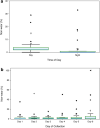Feasibility of a continuous, multi-sensor remote health monitoring approach in persons living with neurodegenerative disease
- PMID: 34705114
- PMCID: PMC8548705
- DOI: 10.1007/s00415-021-10831-z
Feasibility of a continuous, multi-sensor remote health monitoring approach in persons living with neurodegenerative disease
Abstract
Background: Remote health monitoring with wearable sensor technology may positively impact patient self-management and clinical care. In individuals with complex health conditions, multi-sensor wear may yield meaningful information about health-related behaviors. Despite available technology, feasibility of device-wearing in daily life has received little attention in persons with physical or cognitive limitations. This mixed methods study assessed the feasibility of continuous, multi-sensor wear in persons with cerebrovascular (CVD) or neurodegenerative disease (NDD).
Methods: Thirty-nine participants with CVD, Alzheimer's disease/amnestic mild cognitive impairment, frontotemporal dementia, Parkinson's disease, or amyotrophic lateral sclerosis (median age 68 (45-83) years, 36% female) wore five devices (bilateral ankles and wrists, chest) continuously for a 7-day period. Adherence to device wearing was quantified by examining volume and pattern of device removal (non-wear). A thematic analysis of semi-structured de-brief interviews with participants and study partners was used to examine user acceptance.
Results: Adherence to multi-sensor wear, defined as a minimum of three devices worn concurrently, was high (median 98.2% of the study period). Non-wear rates were low across all sensor locations (median 17-22 min/day), with significant differences between some locations (p = 0.006). Multi-sensor non-wear was higher for daytime versus nighttime wear (p < 0.001) and there was a small but significant increase in non-wear over the collection period (p = 0.04). Feedback from de-brief interviews suggested that multi-sensor wear was generally well accepted by both participants and study partners.
Conclusion: A continuous, multi-sensor remote health monitoring approach is feasible in a cohort of persons with CVD or NDD.
Keywords: Adherence; Cerebrovascular disease; Neurodegenerative disease; Remote monitoring; User acceptance; Wearable sensors.
© 2021. Crown.
Conflict of interest statement
On behalf of all authors, the corresponding author states that there is no conflict of interest.
Figures




References
MeSH terms
LinkOut - more resources
Full Text Sources
Medical

